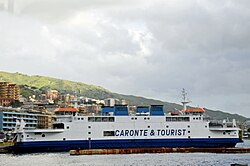Prins Johan Friso
|
The ship as Acciarello in Messina .
|
||||||||||||||||||||||
|
||||||||||||||||||||||
|
||||||||||||||||||||||
|
||||||||||||||||||||||
|
||||||||||||||||||||||
|
||||||||||||||||||||||
The Prins Johan Friso is a 1997 built, former double-ended ferry of the Dutch shipping company Provinciale Stoombootdiensten in Zeeland , which used the ship in ferry traffic on the Scheldt . The ship has been operating in Italy as Acciarello since 2006 .
history
The ship was under the hull number 382 at the shipyard De Schelde built. The construction costs amounted to 68 million guilders .
The keel was laid in June 1996, the launch on January 25, 1997 following the launch of the ship . Godmother was the then Minister for Transport and Waterways, Annemarie Jorritsma . The completion of the ship took place on May 22, 1997. The ship was named after Friso von Orange-Nassau .
The Prins Johan Friso was used together with the almost identical Queen Beatrix on the route between Vlissingen and Breskens . It replaced the Prinses Juliana here , who switched to the Kruiningen –Perkpolder route . The Prins Johan Friso was urgently needed by the shipping company, since since the Prinses Margriet was decommissioned at the end of 1995, no replacement ship was available in the event of a ferry failure.
The shipping company Provinciale Stoombootdiensten in Zeeland ended the ferry service on the Scheldt on March 15, 2003, one day after the opening of the Westerschelden tunnel . The ferry, like the Queen Beatrix , was then taken over by the shipping company BBA Fast Ferries, which maintained passenger traffic across the Scheldt between Vlissingen and Breskens until the completion of smaller ferries of the type Damen Fast Ferry 3717 . The ship's use ended on May 1, 2004.
On May 27, 2004 the ferry was sold to the company MPS Leasing & Factoring, who chartered it to the shipping company Caronte & Tourist . Before it was used by Caronte & Tourist, the ferry at Fincantieri in Palermo was extensively rebuilt. From the beginning of 2006, Caronte & Tourist operated the ship as Acciarello under the Italian flag between Villa San Giovanni and Messina in Sicily . In 2012, the ship was chartered to Blu Navy, which used it from April 2012 between Portoferraio and Piombino on Elba . At the end of September 2012, Blu Navy gave up the connection. In the summer months of 2013 and 2014, the ship sailed again for Blu Navy on the resumed connection to Elba. In the winter months it ran only sporadically between Villa San Giovanni and Messina and was otherwise in Messina launched .
In 2015 the ship was sold by MPS Leasing & Factoring to BN di Navigazione, the parent company of Blu Navy. Since then, it has been in use in ferry traffic to Elba in the summer months. The ship's crew consists of 19 people.
Technical data and equipment
The propulsion of the ship takes place diesel electrically by four of ABB -Jumont Schneider Electric motors each with 1500 kW power driven azimuth thruster , two of which are located at both ends of the vessel. For electricity for the drive motors are four Stork - Wärtsilä - diesel engines (type: 9FHD240-G), each of which drives each with 1,655 kW power available a generator. Four generators powered by Volvo Penta diesel engines are available for additional electricity requirements on board .
The ship has two vehicle decks with five lanes each. At Provinciale Stoombootdiensten in Zeeland, both were continuous vehicle decks. A total of 210 cars could be transported. There was space for 104 on the lower and 106 on the upper vehicle deck. Trucks can also be transported on the lower vehicle deck.
The ship was extensively rebuilt for use in Italy. A ramp was installed at both ends to access the lower vehicle deck. The two vehicle decks were connected to one another via an internal ramp. The upper vehicle deck was widened at the ends to enable easy turning and travel to the internal ramp on these transported vehicles. The capacity of the ship is given as 800 passengers and 230 cars.
The passenger facilities are located above the upper vehicle deck. In front of the superstructure with the passenger facilities and the wheelhouses , the upper vehicle deck is open at both ends.
Web links
- Verboot Prins Johan Friso , website about the PSD ferries
Individual evidence
- ^ M / S Prins Johan Friso , Facta om Fartyg. Retrieved October 8, 2019.
- ↑ Prince Johan Friso. In: Schip & Werf de Zee , July / August 1997, p. 7 ISSN 0926-4213 .
- ^ The Society , Blu Navy. Retrieved October 8, 2019.
- ↑ Blu Navy sull'Elba ripartita con Acciarello , La Gazzetta Marittima, April 8, 2017. Accessed October 8, 2019.
- ↑ The Fleet , Blu Navy. Retrieved October 8, 2019.
